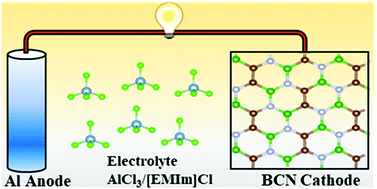BCN monolayer for high capacity Al-based dual-ion batteries†
Abstract
Recent advances in the field of Al dual-ion batteries have put forward a major challenge of developing a novel and advanced cathode material that can provide high specific capacity, besides maintaining a constant high voltage. In this context, significant research has been carried out to identify new electrochemical energy storage materials, which suggest the applicability of low dimensional materials as an excellent choice due to their high surface-to-volume ratio. Herein, we perform first principles calculations to investigate the BCN monolayer as a suitable cathode material for Al dual-ion batteries. AlCl4 has been found to reversibly adsorb on the BCN monolayer with a significant charge transfer of 0.9 |e| from BCN to AlCl4, indicating the oxidation of BCN monolayer during the charging process. Moreover, the BCN monolayer shows excellent structural stability on systematically increasing the concentration of adsorbed AlCl4, and could provide an open circuit voltage of 1.8 V (average voltage is 1.43 V) with a high specific capacity of 316.9 mA h gBCN−1 at the maximum concentration of AlCl4 adsorption. The adsorption of AlCl4 also enables good electronic conductivity. Diffusion energy calculations reveal a minimum energy barrier of 0.12 eV for the migration of AlCl4 within BCN, ensuring a fast charge/discharge rate. Consequently, these findings suggest that the BCN monolayer could be a potential cathode material for Al dual-ion batteries, and motivates us to carry out further studies on similar low dimensional materials to improve the performance of Al dual-ion batteries.



 Please wait while we load your content...
Please wait while we load your content...